100+ Tricky Riddles for Kids and Adults [With Answers]
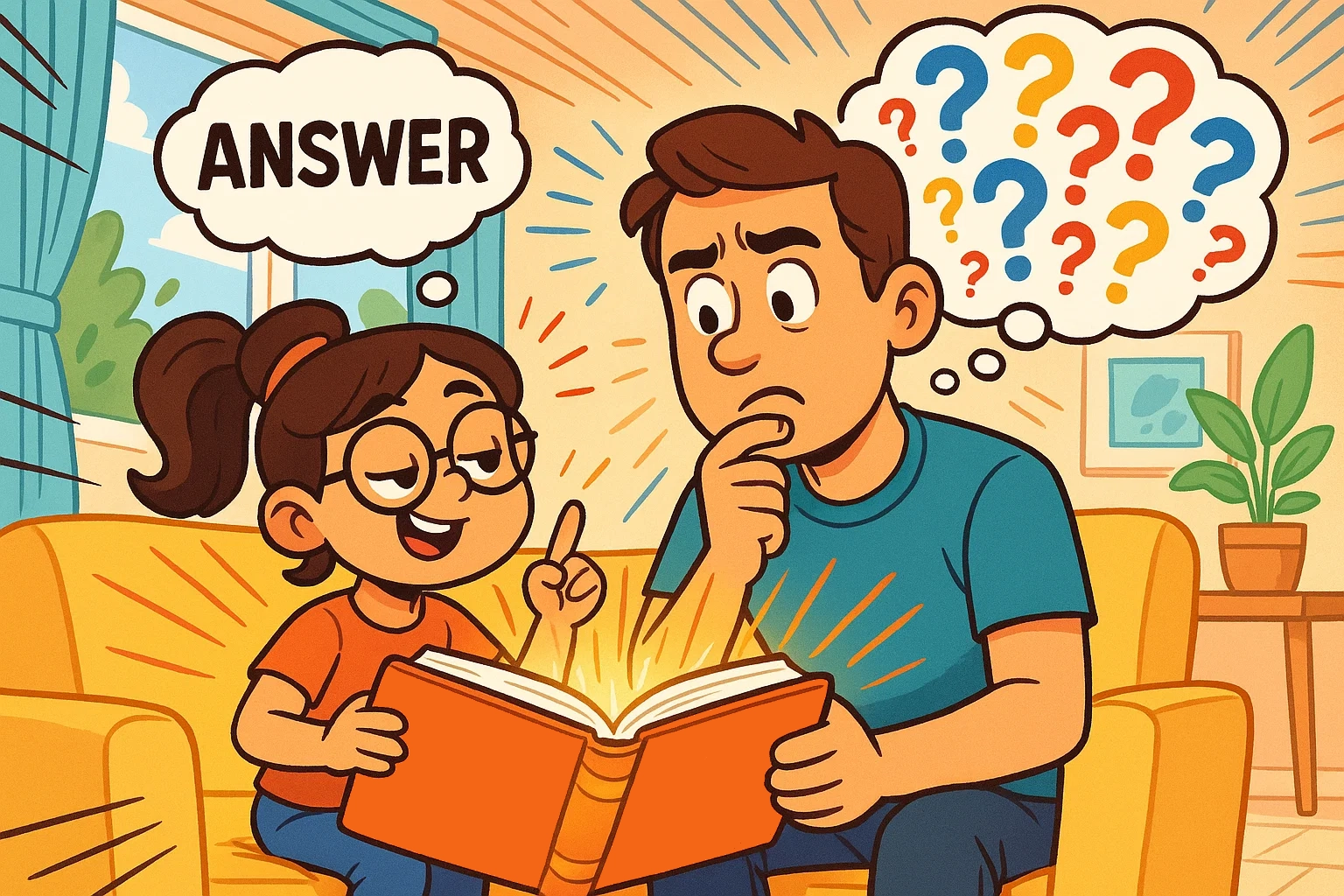
Riddles have captivated children and adults for centuries, offering a unique blend of entertainment and mental exercise. Whether you’re looking for easy riddles to engage younger kids or hard riddles to challenge older children, this comprehensive collection provides something for every age and skill level. From funny riddles that spark laughter to math riddles that sharpen numerical reasoning, you’ll find diverse options to keep young minds engaged and growing.
What is a riddle and how to use riddles
Understanding the nature of riddles helps you choose the right ones for your child’s developmental stage and use them effectively in daily interactions.
Riddle definition and purpose
A riddle is a question or statement that requires creative thinking to solve. Typically presented as a puzzle, riddles use clever wording, metaphors, or double meanings to conceal the answer. The purpose extends beyond simple entertainment. Riddles encourage children to think critically, look at problems from multiple angles, and develop patience when searching for solutions.
Research from the APA PsycNet suggests that regular exposure to riddles may help children develop stronger analytical skills. When kids encounter a tricky riddle, they learn to break down complex information into manageable parts. This process mirrors problem-solving approaches used in academic subjects and real-world situations.
Difference between a riddle and a brain teaser
While people often use these terms interchangeably, subtle differences exist. Riddles typically rely on wordplay, metaphors, or descriptive clues that point toward a single answer. A classic example: “What has hands but cannot clap?” (A: A clock)
Brain teasers encompass a broader category of mental challenges. They may include logic puzzles, math problems, visual puzzles, or lateral thinking exercises. All riddles qualify as brain teasers, but not all brain teasers are riddles. For instance, “If five cats can catch five mice in five minutes, how long does it take one cat to catch one mouse?” is a brain teaser that uses mathematical logic rather than wordplay.
Both formats help kids develop critical thinking skills, though they engage different cognitive pathways.
Games for kids: using riddles for fun
Incorporating riddles into everyday activities creates natural learning opportunities. During car rides, ask your child an easy riddle and see how long it takes them to solve it. At dinner, family members can take turns sharing their favorite riddle of the day.
You can organize riddle scavenger hunts where each clue leads to the next location. For birthday parties, create teams that compete to solve a list of riddles within a time limit. These games for kids transform abstract thinking into active play, making cognitive development feel effortless and enjoyable.
Easy Riddles for Kids
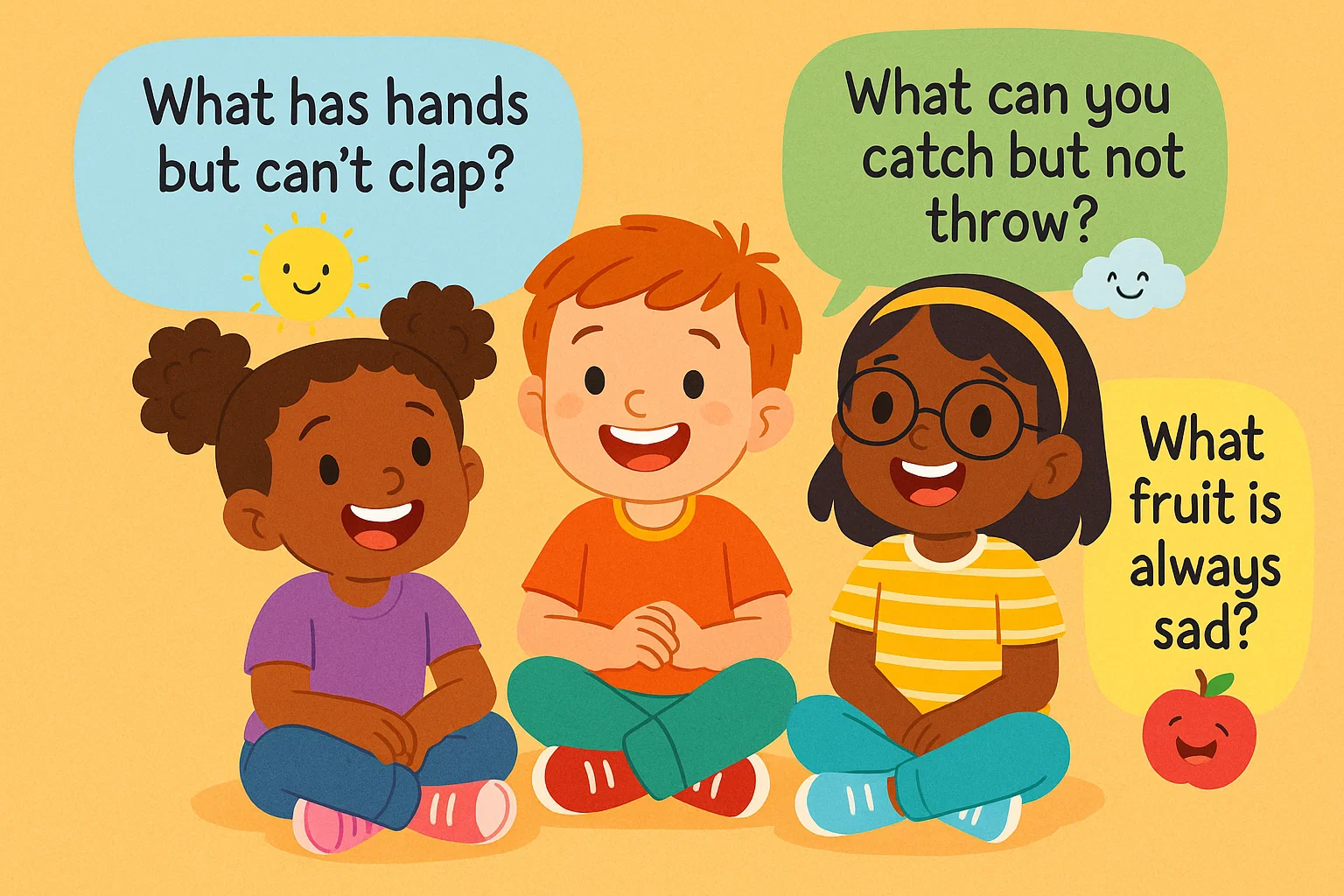
Starting with simple riddles builds confidence and helps children understand the basic structure of these puzzles.
Simple brain teasers for quick fun
Easy riddles introduce the concept without overwhelming young solvers. Here are examples perfect for building confidence:
- What has to be broken before you can use it? A: An egg
- What has a face and two hands but no arms or legs? A: A clock
- What gets wet while drying? A: A towel
- What can you catch but not throw? A: A cold
- What has legs but doesn’t walk? A: A table
- What has one eye but can’t see? A: A needle
- What runs but never walks? A: Water
- What has a neck but no head? A: A bottle
- What gets bigger the more you take away? A: A hole
- What has words but never speaks? A: A book
These fun brain teasers require minimal background knowledge, making them accessible to children just learning to solve puzzles. The answers connect to everyday objects, helping younger kids recognize that solving riddles draws on familiar experiences.
Riddles for kindergarten and young students
Children around 6 years old benefit from riddles with visual or concrete elements. These examples work well for kindergarten-age children:
- What is full of holes but still holds water? A: A sponge
- What has four wheels and flies? A: A garbage truck
- What comes down but never goes up? A: Rain
- What has a thumb and four fingers but is not alive? A: A glove
- What has teeth but cannot bite? A: A comb
- What goes up and down but doesn’t move? A: Stairs
- What has a bottom at the top? A: Your legs
- What can travel around the world while staying in one corner? A: A stamp
- What has many keys but can’t open a door? A: A piano
- What comes once in a minute, twice in a moment, but never in a thousand years? A: The letter M
When you introduce riddles to kindergarteners, start with three to five options at a time. This prevents frustration and maintains enthusiasm for the activity.
Funny Riddles
Humor makes learning memorable. Funny riddles combine wordplay with silly scenarios that make children laugh while thinking.
Laugh-out-loud funny riddles
These riddles prioritize entertainment value while still requiring problem-solving:
- Why did the math book look sad? A: Because it had too many problems
- What do you call a bear with no teeth? A: A gummy bear
- Why don’t scientists trust atoms? A: Because they make up everything
- What do you call a sleeping bull? A: A bulldozer
- Why did the bicycle fall over? A: Because it was two-tired
- What do you call cheese that isn’t yours? A: Nacho cheese
- Why can’t a leopard hide? A: Because he’s always spotted
- What did one wall say to the other wall? A: “I’ll meet you at the corner”
- Why did the cookie go to the doctor? A: Because it felt crumbly
- What building has the most stories? A: The library
Silly word play riddles
Word play riddles help children understand multiple meanings and homophones:
- What kind of tree can fit in your hand? A: A palm tree
- What has ears but cannot hear? A: Corn
- What room has no doors or windows? A: A mushroom
- What kind of band never plays music? A: A rubber band
- What has a head and a tail but no body? A: A coin
- What gets wetter the more it dries? A: A towel
- What can you hold without touching it? A: A conversation
- What runs around the yard without moving? A: A fence
- What has branches but no leaves, trunk, or fruit? A: A bank
- What can jump higher than a building? A: Anything—buildings can’t jump!
Quick and amusing riddle jokes
Short riddles work well for quick transitions between activities:
- What starts with E, ends with E, and has one letter in it? A: An envelope
- What begins with T, ends with T, and has T in it? A: A teapot
- What is always in front of you but can’t be seen? A: The future
- What is black when clean and white when dirty? A: A chalkboard
- What can fill a room but takes up no space? A: Light
- What is so fragile that saying its name breaks it? A: Silence
- What has cities but no houses, forests but no trees, and water but no fish? A: A map
- The more you take, the more you leave behind. What are they? A: Footsteps
- What belongs to you but is used more by others? A: Your name
- What invention lets you look right through a wall? A: A window
Math Riddles
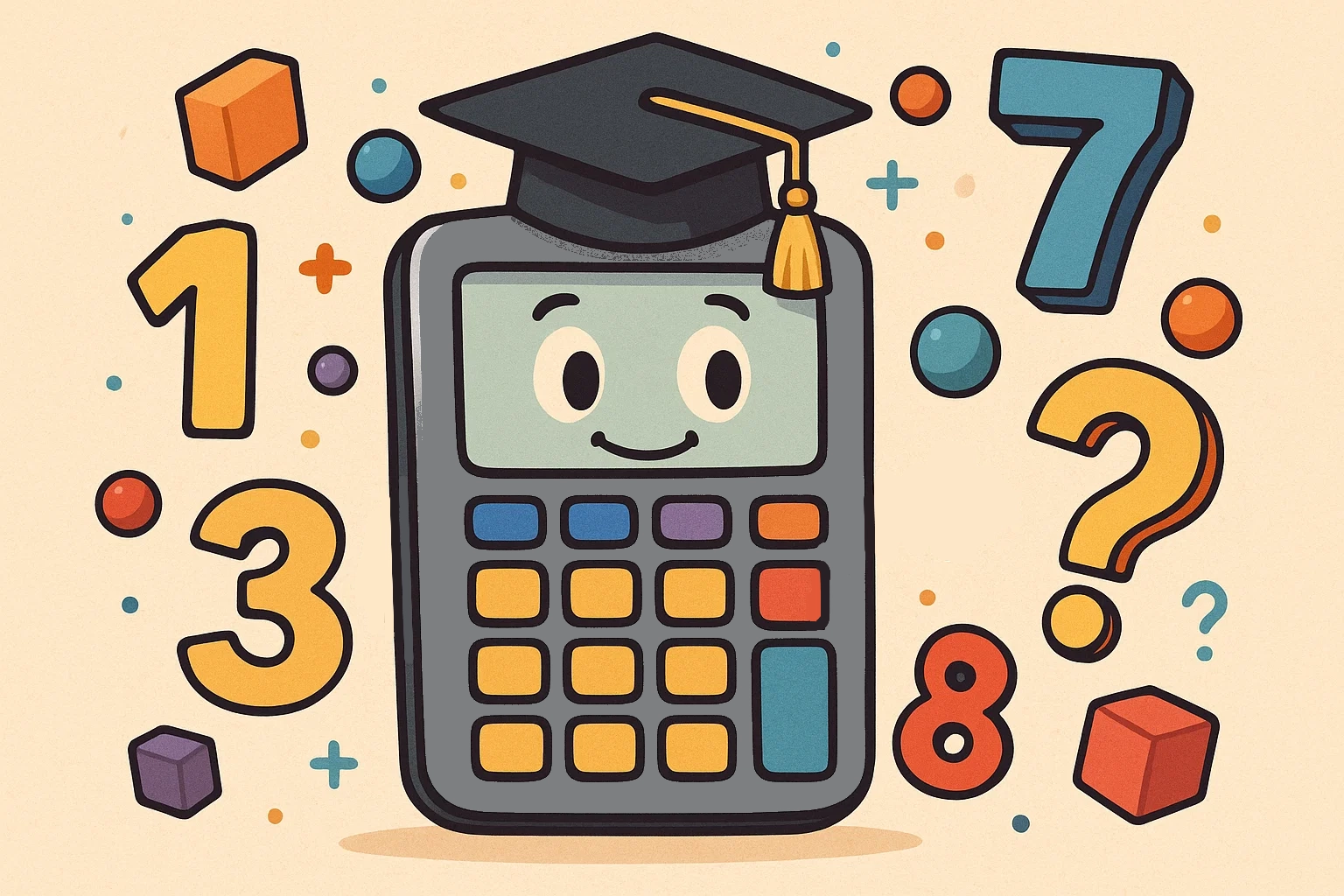
Math riddles combine numerical reasoning with problem-solving skills, offering a fun way to practice mathematical concepts outside traditional worksheets.
Math riddles for kids
These puzzles introduce basic arithmetic and logical thinking:
- I am an odd number. Take away one letter and I become even. What number am I? A: Seven (remove the ‘s’)
- If two’s company and three’s a crowd, what are four and five? A: Nine
- What three numbers give the same result when multiplied and added together? A: 1, 2, and 3 (1+2+3=6 and 1×2×3=6)
- How many months have 28 days? A: All 12 months
- A farmer has 17 sheep and all but 9 die. How many are left? A: 9
- If you have three apples and take away two, how many do you have? A: Two (the ones you took)
- What is the smallest number that increases by 12 when flipped upside down? A: 86 (becomes 98)
- I add five to nine and get two. The answer is correct, but how? A: When it’s 9 AM, add 5 hours to get 2 PM
- If there are 12 fish and half of them drown, how many are left? A: 12 (fish don’t drown)
- Using only addition, how do you add eight 8s to get the number 1,000? A: 888 + 88 + 8 + 8 + 8 = 1,000
Number puzzles and logic riddles
These require deeper analytical thinking:
- I am a three-digit number. My tens digit is five more than my ones digit, and my hundreds digit is eight less than my tens digit. What number am I? A: 194
- If you multiply this number by any other number, the answer will always be the same. What number is it? A: Zero
- What can you put between 7 and 8 to make the result greater than 7 but less than 8? A: A decimal point (7.8)
- A grandfather, two fathers, and two sons went fishing. Each caught one fish. How many fish did they catch in total? A: Three (grandfather, father, and son—the father is both a father and a son)
- What number do you get when you multiply all the numbers on a telephone’s number pad? A: Zero (because zero is on the pad)
Challenging math brain teasers
For children 8 years old and up who enjoy complex problems:
- I am thinking of two numbers. The product of these numbers is 16, and their sum is 10. What are the numbers? A: 2 and 8
- A snail is at the bottom of a 20-foot well. Each day it climbs up 3 feet, but each night it slides down 2 feet. How many days will it take to reach the top? A: 18 days (on day 18, it reaches the top during the day and doesn’t slide back)
- You have a 3-gallon jug and a 5-gallon jug. How can you measure exactly 4 gallons? A: Fill the 5-gallon jug, pour into the 3-gallon jug (leaving 2 gallons), empty the 3-gallon jug, pour the 2 gallons into it, fill the 5-gallon jug again, and pour into the 3-gallon jug until full (using 1 gallon), leaving 4 gallons in the 5-gallon jug
- What number is one-half of one-quarter of one-tenth of 400? A: 5
- If you take three apples from five apples, what do you have? A: Three apples (the ones you took)
Hard Riddles and Tricky Riddle Challenges
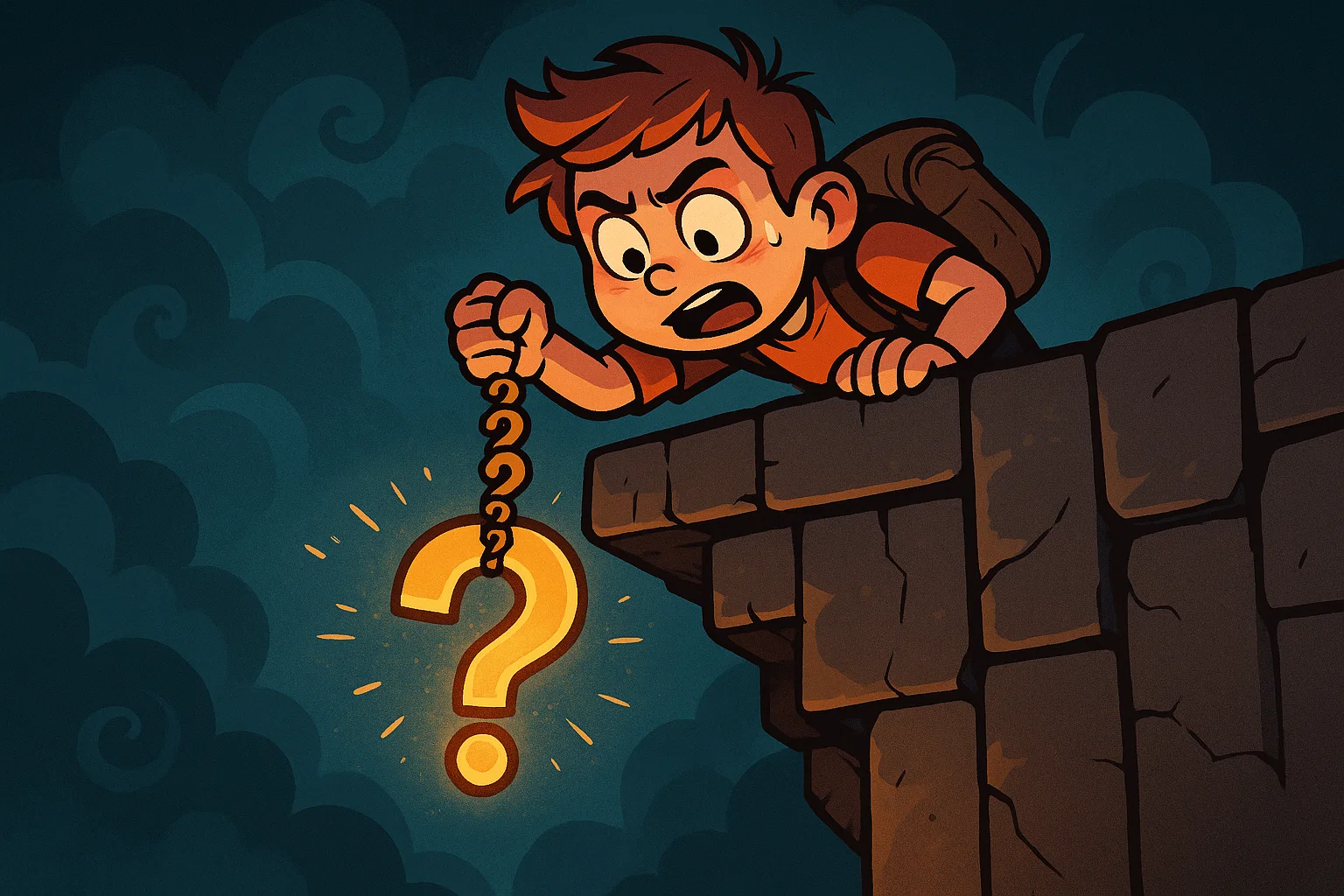
Hard riddles push children to think beyond obvious answers and consider alternative perspectives.
Hard riddles to challenge kids
These puzzles require sustained attention and creative problem-solving:
- What is seen in the middle of March and April that can’t be seen at the beginning or end of either month? A: The letter R
- What word in the English language has three consecutive double letters? A: Bookkeeper
- A man dies of old age on his 25th birthday. How is this possible? A: He was born on February 29
- What can go up a chimney down but can’t go down a chimney up? A: An umbrella
- The person who makes it doesn’t need it. The person who buys it doesn’t use it. The person who uses it doesn’t know it. What is it? A: A coffin
- What word becomes shorter when you add two letters to it? A: Short (add ‘er’ to make ‘shorter’)
- What disappears as soon as you say its name? A: Silence
- What comes once in a year, twice in a week, but never in a day? A: The letter E
- I have cities but no houses, mountains but no trees, and water but no fish. What am I? A: A map
- What has a head, a tail, is brown, and has no legs? A: A penny
Tricky riddle questions for clever solvers
These riddles use misdirection and require careful listening:
- A girl fell off a 20-foot ladder but didn’t get hurt. Why? A: She fell off the bottom rung
- How many letters are in the alphabet? A: Eleven (the word “the alphabet” has 11 letters)
- What five-letter word becomes shorter when you add two letters to it? A: Short
- Before Mount Everest was discovered, what was the highest mountain? A: Mount Everest (it was still the highest, just not discovered)
- What occurs once in every minute, twice in every moment, yet never in a thousand years? A: The letter M
- A rooster lays an egg on top of a barn roof. Which way does it roll? A: Roosters don’t lay eggs
- If a red house is made of red bricks and a yellow house is made of yellow bricks, what is a greenhouse made of? A: Glass
- How can a pants pocket be empty but still have something in it? A: It has a hole in it
- What can run but never walks, has a mouth but never talks, has a head but never weeps, and has a bed but never sleeps? A: A river
- What goes through towns and over hills but never moves? A: A road
Logic riddles that require creative thinking
These challenge kids to use deductive reasoning:
- Three doctors say Robert is their brother. Robert says he has no brothers. Who’s lying? A: No one—the doctors are his sisters
- A man lives on the 20th floor. Every day he takes the elevator down to the lobby. When returning, he takes the elevator to the 10th floor and walks the rest of the way. Why? A: He’s too short to reach the button for the 20th floor
- You see a boat filled with people. It has not sunk, but when you look again, you don’t see a single person. Why? A: All the people were married (not single)
- A man shaves several times a day but still has a beard. Who is this man? A: A barber
- What has 13 hearts but no other organs? A: A deck of cards
Animal Riddles
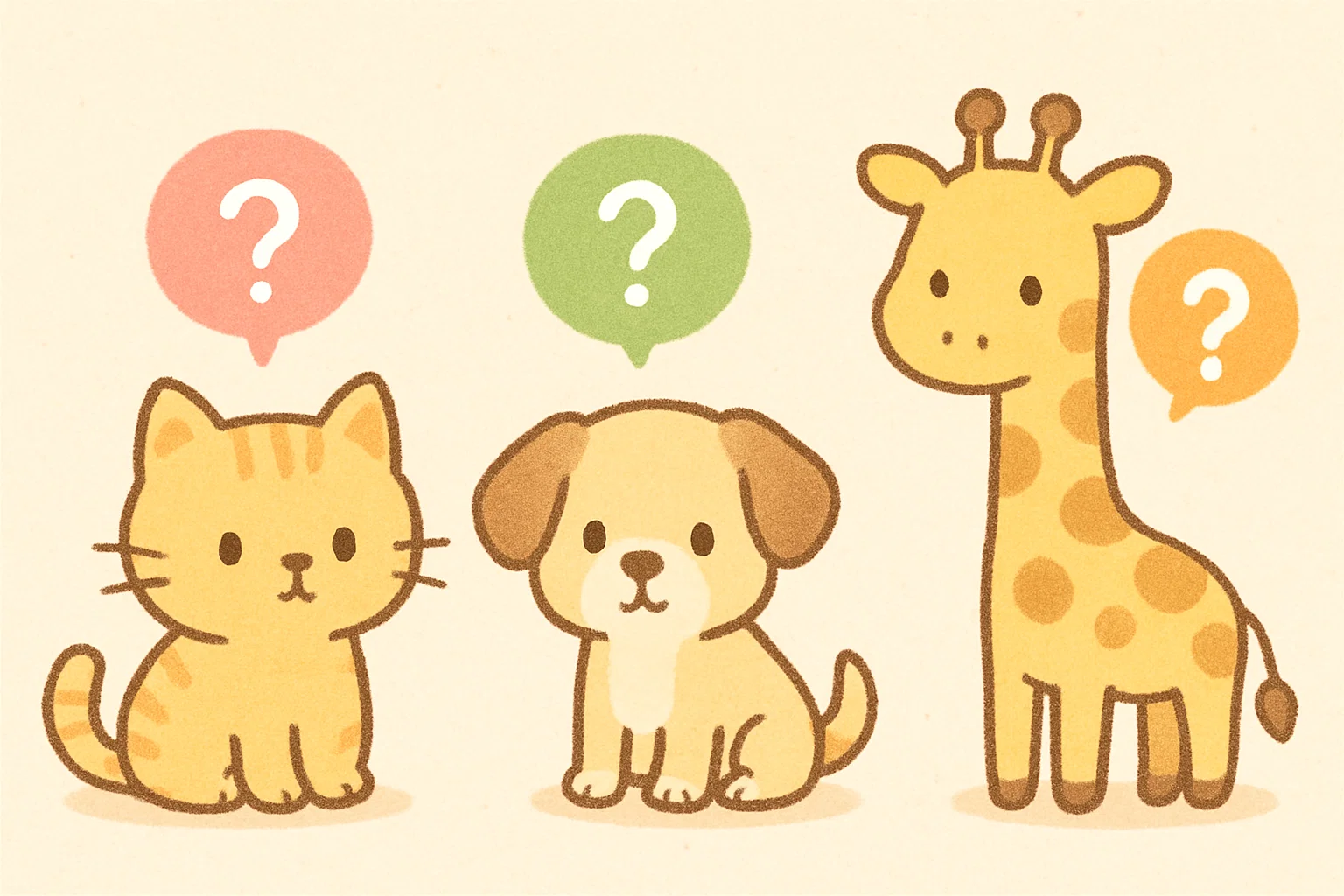
Animal riddles connect problem-solving with children’s natural interest in creatures, making them particularly engaging for younger learners.
Favorite animal riddles for kids
These riddles feature recognizable animals:
- What animal can jump higher than a house? A: Any animal (houses can’t jump)
- What has four legs in the morning, two legs in the afternoon, and three legs in the evening? A: A human (crawling as a baby, walking as an adult, using a cane when old)
- What animal is always at a baseball game? A: A bat
- What kind of cat likes to go bowling? A: An alley cat
- What do you call a sleeping bull? A: A bulldozer
- What do you call a bear with no ears? A: B
- Why don’t elephants use computers? A: They’re afraid of the mouse
- What do you call a pig that does karate? A: A pork chop
- What bird can lift the most weight? A: A crane
- What do you call a fish without eyes? A: Fsh
What Am I? animal brain teasers
These descriptive riddles help children practice inference skills:
- I have a long trunk, big ears, and thick skin. What am I? A: An elephant
- I swim in the ocean, have eight arms, and can change colors. What am I? A: An octopus
- I hop around, carry my baby in a pouch, and live in Australia. What am I? A: A kangaroo
- I’m slow, carry my house on my back, and leave a slimy trail. What am I? A: A snail
- I have black and white stripes and look like a horse. What am I? A: A zebra
- I sleep upside down and come out at night. What am I? A: A bat
- I have a long neck, spots, and eat leaves from tall trees. What am I? A: A giraffe
- I’m small, busy, and live in a colony with a queen. What am I? A: An ant
- I can be a pet, chase mice, and purr when happy. What am I? A: A cat
- I bark, wag my tail, and am known as man’s best friend. What am I? A: A dog
Food Riddles and Everyday Objects
These riddles ground abstract thinking in concrete, familiar items from daily life.
Fun food riddles for kids
Food-themed riddles connect to mealtime experiences:
- What has a heart that doesn’t beat? A: An artichoke
- What kind of room has no doors or windows? A: A mushroom
- What is orange and sounds like a parrot? A: A carrot
- What fruit can you never cheer up? A: A blueberry
- What is always coming but never arrives? A: Tomorrow (also fits the food theme with “tomorrow’s dinner”)
- What type of cheese is made backward? A: Edam
- Why did the tomato turn red? A: Because it saw the salad dressing
- What has eyes but cannot see? A: A potato
- What kind of nut has no shell? A: A doughnut
- What runs but never gets tired? A: Water (from the tap or in a stream)
Riddles about common objects
These puzzles help children recognize properties of household items:
- What has hands but cannot clap? A: A clock
- What has a ring but no finger? A: A telephone
- What can you break without touching it? A: A promise
- What has a spine but no bones? A: A book
- What is full of keys but can’t open any door? A: A keyboard or piano
- What has a face but no eyes, nose, or mouth? A: A clock
- What object has four legs but only one foot? A: A bed
- What has a bank but no money? A: A river
- What has a stem but is not a flower? A: A wine glass
- What can be opened but never closed? A: An egg
Play on words riddles
Word play riddles develop linguistic awareness:
- What has four wheels and flies? A: A garbage truck
- What kind of coat can only be put on when wet? A: A coat of paint
- What goes up but never comes back down? A: Your age
- What is always on its way but never arrives? A: Tomorrow
- What gets sharper the more you use it? A: Your brain
- What can you serve but never eat? A: A tennis ball
- What kind of cup can’t hold water? A: A cupcake
- What kind of ship has two mates but no captain? A: A relationship
- What has one head, one foot, and four legs? A: A bed
- What kind of apple isn’t an apple? A: A pineapple
Holiday Riddles
Seasonal riddles connect cognitive development to celebrations throughout the year.
Seasonal and holiday riddles for kids
These riddles mark special occasions:
- What falls in winter but never gets hurt? A: Snow
- I come with many colors, so beautiful and bright. I turn so many houses into a beautiful sight. What am I? A: Christmas lights
- What kind of egg can you drink? A: Eggnog
- What do you call a snowman in the summer? A: A puddle
- I am red and white, sweet and minty, and you see me during winter holidays. What am I? A: A candy cane
- What do snowmen eat for breakfast? A: Frosted flakes
- What has needles but doesn’t sew? A: A Christmas tree
- I’m made of snow but I’m not cold. Children build me to stand in their yard. What am I? A: A snowman
- What do you call a reindeer with no eyes? A: No-eye deer (no idea)
- What goes around the world but stays in one corner? A: A postage stamp (on holiday cards)
Halloween and winter holiday riddles
These theme-specific puzzles enhance seasonal activities:
Halloween Riddles:
- What room do ghosts avoid? A: The living room
- Why don’t mummies take vacations? A: They’re afraid they’ll relax and unwind
- What kind of music do mummies like? A: Wrap music
- What do you call a witch at the beach? A: A sand-witch
- What’s a ghost’s favorite fruit? A: Boo-berries
Winter Holiday Riddles:
- What do you get when you cross a snowman with a vampire? A: Frostbite
- Why was the snowman looking through the carrots? A: He was picking his nose
- What do elves learn in school? A: The elf-abet
- What do you sing at a snowman’s birthday party? A: Freeze a jolly good fellow
- How does a snowman get to work? A: By icicle
New and fresh riddle topics
Expanding beyond traditional themes keeps children engaged:
- What season is best for trampolines? A: Spring
- What flowers grow between your nose and chin? A: Tulips (two lips)
- What do you call a parade of rabbits hopping backward? A: A receding hare-line
- What’s worse than finding a worm in your apple? A: Finding half a worm
- What kind of tree can you carry in your hand? A: A palm
Benefits of Riddles
The value of riddles extends far beyond entertainment, offering measurable developmental advantages.
Why use riddles for child development
Riddles serve as a practical tool for cognitive growth. When children work to solve a puzzle, they engage multiple thinking processes simultaneously. They must comprehend the question, recall relevant information, identify patterns, and test potential solutions.
This skill proves essential for academic success across all subjects. Children who use riddles regularly often demonstrate improved attention span, as solving these puzzles requires sustained focus.
Beyond cognition, riddles offer social benefits. Sharing riddles with friends or family members creates bonding opportunities and teaches children to take turns, listen actively, and celebrate others’ successes. These soft skills complement academic learning.
Riddles help your child build skills
Critical thinking skills emerge as children learn to analyze information systematically. When faced with a tricky riddle, they must evaluate which details matter and which serve as distractions. This discrimination ability transfers to reading comprehension and scientific reasoning.
Problem-solving skills develop through the trial-and-error process. Children learn that incorrect answers provide valuable information. They discover strategies like working backward from potential answers, breaking complex riddles into smaller parts, or considering unusual interpretations of common words.
Language development accelerates through exposure to wordplay. Riddles introduce children to homophones, metaphors, and multiple meanings. A child who struggles with reading comprehension may find that solving fun riddles strengthens their ability to identify context clues and infer meaning.
Patience and persistence grow as children recognize that challenging problems require time. A child who learns to sit with discomfort while working through a logic puzzle develops grit that serves them throughout life.
| Skill Area | How Riddles Help | Example |
| Critical Thinking | Analyzing clues and eliminating wrong answers | Identifying that “What has hands but can’t clap?” refers to objects, not people |
| Language Development | Learning multiple meanings, wordplay, and metaphors | Understanding that “bank” can mean financial institution or river edge |
| Problem-Solving | Testing hypotheses and learning from mistakes | Trying different number combinations in math riddles |
| Memory | Recalling facts and connecting information | Remembering animal characteristics for animal riddles |
| Creativity | Considering unconventional perspectives | Thinking about what “runs but never walks” might mean |
| Social Skills | Taking turns, sharing ideas, and collaborating | Working together to solve a list of riddles |
Brain teasers boost comprehension and focus
Regular exposure to brain teasers may improve reading comprehension by strengthening inference skills. When children solve riddles, they practice reading between the lines and identifying implicit information. These same skills help them understand character motivations in stories or identify main ideas in informational texts.
Attention span benefits from the engaging nature of riddles. Unlike passive activities, solving riddles requires active participation. Children must maintain focus from the initial question through to the solution. This sustained attention practice translates to longer concentration during homework or reading assignments.
Processing speed may improve as children become more practiced at pattern recognition. Younger kids might need several minutes to solve an easy riddle. With experience, that same child can solve similar puzzles in seconds, demonstrating improved cognitive efficiency.
How to help your child create riddles
Creating original riddles represents an advanced cognitive skill that reinforces understanding of riddle structure while fostering creativity.
Follow simple steps to write a riddle
Teaching your child to make riddles follows a straightforward process:
Step 1: Choose an answer first. Start with an object, concept, or word that interests your child. Simple household items work well for beginners.
Step 2: List characteristics. Write down everything your child notices about the chosen answer. What does it look like? What does it do? Where do you find it? What is it made of?
Step 3: Turn characteristics into clues. Transform descriptive statements into questions or mysterious phrases. “It’s made of glass” becomes “I’m transparent but not invisible.”
Step 4: Add misdirection. Include one or two details that might lead someone toward incorrect answers. This makes the riddle more challenging and engaging.
Step 5: Test it. Share the riddle with family members. If everyone guesses immediately, add more misdirection. If no one can solve it, make the clues more specific.
Brainstorming answers for a tricky riddle
Help your child generate creative answers by exploring different categories:
Everyday objects: Look around your home for inspiration. Kitchen items, furniture, and toys all make excellent riddle subjects.
Nature elements: Animals, plants, weather phenomena, and geographical features provide rich material for descriptive riddles.
Abstract concepts: Older children can tackle ideas like time, emotions, or relationships, creating more philosophical riddles.
Word play opportunities: Identify words with multiple meanings or homophones that enable clever linguistic puzzles.
Encourage your child to maintain a riddle journal where they collect potential answers. Over time, they’ll develop an eye for items that would make interesting puzzles.
Creative tips to help your child succeed
Start with simple formats. “What Am I?” riddles provide an accessible structure for beginners. As confidence grows, experiment with different formats.
Use rhyme for younger children. Riddles that rhyme feel more natural for kids around 6 years old. The rhythm helps them remember their creations and adds an element of poetry.
Draw the answer. Visual learners benefit from sketching their riddle answer before writing clues. This concrete representation helps them identify visual characteristics to include as hints.
Collaborate on the first few. Kids can help write riddles by working alongside you. You might suggest the answer while they generate clues, or vice versa. This scaffolding builds skills and confidence.
Celebrate all attempts. Even if a riddle is too easy or too hard, praise the creative effort. Learning to craft effective riddles takes practice. Each attempt teaches your child something new about language, logic, and communication.
Create a family riddle book. Compile your child’s riddles into a special collection. This tangible product validates their creative work and provides motivation to continue developing new puzzles. Family members can contribute their own riddles, making it a collaborative project that spans months or years.
